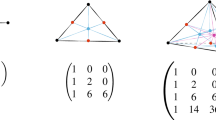Abstract
We introduce a generalization of the celebrated Lovász theta number of a graph to simplicial complexes of arbitrary dimension. Our generalization takes advantage of real simplicial cohomology theory, in particular combinatorial Laplacians, and provides a semidefinite programming upper bound of the independence number of a simplicial complex. We consider properties of the graph theta number such as the relationship to Hoffman’s ratio bound and to the chromatic number and study how they extend to higher dimensions. Like in the case of graphs, the higher dimensional theta number can be extended to a hierarchy of semidefinite programming upper bounds reaching the independence number. We analyze the value of the theta number and of the hierarchy for dense random simplicial complexes.
Similar content being viewed by others
References
M. Anjos and J. B. Lasserre, Handbook on Semidefinite, Conic and Polynomial Optimization, International Series in Operations Research & Management Science, Vol. 166, Springer, New York, 2012.
A. Ben-Tal and A. Nemirovski, Lectures on Modern Convex Optimization, MPS/SIAM Series on Optimization, Society for Industrial and Applied Mathematics, Philadelphia, PA; Mathematical Programming Society, Philadelphia, PA, 2001.
S. Boyd and L. Vandenberghe, Convex Optimization, Cambridge University Press, Cambridge, 2004.
A. E. Brouwer and W. H. Haemers, Spectra of Graphs, Univesitext, Springer, New York, 2012.
H. Cohn, A. Kumar, S. D. Miller, D. Radchenko and M. S. Viazovska, The sphere packing problem in dimension 24, Annals of Mathematics 185 (2017), 1017–1033.
A. Coja-Oghlan, The Lovász number of random graphs, Combinatorics, Probability and Computing 14 (2005), 439–465.
P. E. B. DeCorte, D. de Laat and F. Vallentin, Fourier analysis on finite groups and the Lovász theta-number of Cayley graphs, Experimental Mathematics 23 (2014), 146–152.
P. Delsarte, An algebraic approach to the association schemes of coding theory, Philips Journal of Research 10(1973).
D. Dotterrer, T. Kaufman and U. Wagner, On expansion and topological overlap, Geometriae Dedicata 195 (2018), 3017–317.
D. Dotterrer, L. Guth and M. Kahle, 2-complexes with large 2-girth, Discrete & Computational Geometry 59 (2018), 383–412.
A. M. Duval, C. J. Klivans and J. L. Martin, Simplicial and cellular trees, in Recent Trends in Combinatorics, The IMA Volumes in Mathematics and its Applications, Vol. 159, Springer, Cham, 2016, pp. 713–752.
D. Ellis, E. Friedgut and H. Pilpel, Intersecting families of permutations, Journal of the American Mathematical Society 24 (2011), 649–682.
D. Ellis, Y. Filmus and E. Friedgut, Triangle-intersecting families of graphs, Journal of the European Mathematical Society 14 (2012), 841–885.
S. Evra, K. Golubev and A. Lubotzky, Mixing properties and the chromatic number of Ramanujan complexes, International Mathematics Research Notices 22 (2015), 11520–11548.
S. Evra and T. Kaufman, Bounded degree cosystolic expanders of every dimension, in STOC’16—Proceedings of the 48th Annual ACM SIGACT Symposium on Theory of Computing, ACM, New York, 2016, pp. 36–48.
U. Feige and E. Ofek, Spectral techniques applied to sparse random graphs, Random Structures & Algorithms 27 (2005), 251–275.
H. Garland, p-adic curvature and the cohomology of discrete subgroups of p-adic groups, Annals of Mathematics 97 (1973), 375–423.
B. Gärtner and J. Matoušek, Approximation Algorithms and Semidefinite Programming, Springer, Heidelberg, 2012.
K. Golubev, On the chromatic number of a simplicial complex, Combinatorica 37 (2017), 953–964.
M. Gromov, Singularities, expanders and topology of maps. Part 2: From combinatorics to topology via algebraic isoperimetry, Geometric and Functional Analysis 20 (2010), 416–526.
A. Gundert and U. Wagner, On eigenvalues of random complexes, Israel Journal of Mathematics 216 (2016), 545–582.
C. Hoffman, M. Kahle and E. Paquette, Spectral gaps of random graphs and applications to random topology, arXiv.math:1201.0425.
D. Horak and J. Jost, Spectra of combinatorial Laplace operators on simplicial complexes, Advances in Mathematics 244 (2013), 303–336.
F. Juhász, The aymptotic behaviour of Lovász theta function for random graphs, Combinatorica 2 (1982), 153–155.
M. Kahle, Random simplicial complexes, in Handbook of Discrete and Computational Geometry, CRC, Boca Raton, FL, 2017, pp. 581–603.
G. Kalai, Enumeration of ℚ-acyclic simplicial complexes, Israel Journal of Mathematics 45 (1983), 337–351.
T. Kaufman, D. Kazhdan and A. Lubotzky, Isoperimetric inequalities for Ramanujan complexes and topological expanders, Geometric and Functional Analysis 26 (2016), 250–287.
M. Krivelevich and B. Sudakov, The chromatic numbers of random hypergraphs, Random Structures & Algorithms 12 (1998), 381–403.
J. B. Lasserre, An explicit equivalent positive semidefinite program for nonlinear 0–1 programs, SIAM Journal on Optimization 12 (2002), 756–769.
M. Laurent, A comparison of the Sherali-Adams, Lovász-Schrijver and Lasserre relaxationsfor 0–1 programming, Mathematics of Operations Research 28 (2003), 470–496.
N. Linial and R. Meshulam, Homological connectivity of random 2-complexes, Combinatorica 26 (2006), 475–487.
L. Lovász, On the Shannon capacity of a graph, IEEE Transactions on Information Theory 25 (1979), 1–7.
A. Lubotzky, Ramanujan complexes and high dimensional expanders, Japanese Journal of Mathematics 9 (2014), 137–169.
A. Lubotzky and R. Meshulam, A Moore bound for simplicial complexes, Bulletin of the London Mathematical Society 39 (2007), 353–358.
J. Matouşek, M. Tancer and U. Wagner, Hardness of embedding simplicial complexes in ℝd, Journal of the European Mathematical Society 13 (2011), 259–295.
F. M. de Oliveira Filho and F. Vallentin, Computing upper bounds for packing densities of congruent copies of a convex body, in New Trends in Intuitive Geometry, Bolyai Society Mathematical Studies, Vol. 27, Springer, Berlin-Heidelberg, 2018, pp. 155–188.
O. Parzanchevski and R. Rosenthal, Simplicial complexes: Spectrum, homology and random walks, Random Structures & Algorithms 50 (2017), 225–261.
O. Parzanchevski, R. Rosenthal and R. J. Tessler, Isoperimetric inequalities in simplicial complexes, Combinatorica 36 (2016), 195–227.
L. Vandenberghe and S. Boyd, Semidefinite programming, SIAM Review 38 (1996), 49–95.
M. S. Viazovska, The sphere packing problem in dimension 8, Annals of Mathematics 185 (2017), 991–1015.
Author information
Authors and Affiliations
Corresponding author
Rights and permissions
About this article
Cite this article
Bachoc, C., Gundert, A. & Passuello, A. The theta number of simplicial complexes. Isr. J. Math. 232, 443–481 (2019). https://doi.org/10.1007/s11856-019-1880-8
Received:
Revised:
Published:
Issue Date:
DOI: https://doi.org/10.1007/s11856-019-1880-8




